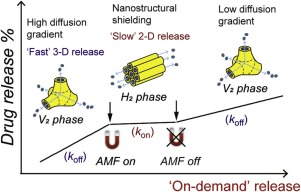当前位置:
X-MOL 学术
›
Colloids Surf. B Biointerfaces
›
论文详情
Our official English website, www.x-mol.net, welcomes your
feedback! (Note: you will need to create a separate account there.)
Magnetically-stimulated transformations in nanostructure of lipid mesophases: Effect of structure of iron oxide nanoparticles.
Colloids and Surfaces B: Biointerfaces ( IF 5.4 ) Pub Date : 2020-03-10 , DOI: 10.1016/j.colsurfb.2020.110965 Xiaohan Sun 1 , Nicolas Alcaraz 1 , Ruirui Qiao 2 , Adrian Hawley 3 , Angel Tan 1 , Ben J Boyd 1
Colloids and Surfaces B: Biointerfaces ( IF 5.4 ) Pub Date : 2020-03-10 , DOI: 10.1016/j.colsurfb.2020.110965 Xiaohan Sun 1 , Nicolas Alcaraz 1 , Ruirui Qiao 2 , Adrian Hawley 3 , Angel Tan 1 , Ben J Boyd 1
Affiliation

|
Nanostructured lipid-based liquid crystalline (LLC) systems can display different drug release rates and also be stimuli-responsive, rendering them the potential to serve as 'on-demand' drug delivery systems. In this study, a magnetically-responsive cubic phase nanocomposite was engineered by doping iron oxide nanoparticles (IONPs) into a phytantriol (PHYT)-based lipid that exhibits transformation in nanostructure under external alternating magnetic field (AMF). The effects of IONP surface hydrophilicity/hydrophobicity, size and concentration were determined in dispersed systems, and the effect of hydration state of the system was also assessed. Time-resolved small angle X-ray scattering (SAXS) was used to probe the impact of these variables on the transformation of nanostructure with and without the application of AMF. The inclusion of both hydrophobic and hydrophilic IONPs reduced the temperature of the phase transition from the inverted bicontinuous cubic (V2) phase to inverted hexagonal (H2) phase and imparted magnetic-responsiveness to the systems. The size of the IONPs played an important role in governing the phase reversibility of the dispersed systems, while the concentration of the IONPs had more impact on the phase behaviour of the bulk systems. These successfully demonstrated a completely reversible magneto-responsive phase transition in the nanostructured LLC systems through optimising the selection of IONPs.
中文翻译:

脂质中间相纳米结构中的磁刺激转化:氧化铁纳米颗粒结构的影响。
纳米结构基于脂质的液晶(LLC)系统可以显示不同的药物释放速率,并且具有刺激性,从而使其有可能用作“按需”药物输送系统。在这项研究中,通过将氧化铁纳米颗粒(IONPs)掺杂到基于植物三醇(PHYT)的脂质中,从而设计了磁性响应立方相纳米复合材料,该脂质在外部交变磁场(AMF)下展现出纳米结构的转变。测定了分散体系中IONP表面亲水性/疏水性,尺寸和浓度的影响,并评估了系统水化状态的影响。时间分辨小角度X射线散射(SAXS)用于探测这些变量对使用和不使用AMF的纳米结构转变的影响。包含疏水性和亲水性IONP都降低了从反向双连续立方(V2)相到反向六角(H2)相的相变温度,并赋予了系统磁响应性。IONP的大小在控制分散系统的相可逆性中起着重要作用,而IONP的浓度对整体系统的相行为影响更大。这些通过优化IONP的选择成功地证明了纳米结构LLC系统中的完全可逆的磁响应相变。IONP的大小在控制分散系统的相可逆性中起着重要作用,而IONP的浓度对整体系统的相行为影响更大。这些通过优化IONP的选择成功地证明了纳米结构LLC系统中的完全可逆的磁响应相变。IONP的大小在控制分散系统的相可逆性中起着重要作用,而IONP的浓度对整体系统的相行为影响更大。这些通过优化IONP的选择成功地证明了纳米结构LLC系统中的完全可逆的磁响应相变。
更新日期:2020-03-10
中文翻译:

脂质中间相纳米结构中的磁刺激转化:氧化铁纳米颗粒结构的影响。
纳米结构基于脂质的液晶(LLC)系统可以显示不同的药物释放速率,并且具有刺激性,从而使其有可能用作“按需”药物输送系统。在这项研究中,通过将氧化铁纳米颗粒(IONPs)掺杂到基于植物三醇(PHYT)的脂质中,从而设计了磁性响应立方相纳米复合材料,该脂质在外部交变磁场(AMF)下展现出纳米结构的转变。测定了分散体系中IONP表面亲水性/疏水性,尺寸和浓度的影响,并评估了系统水化状态的影响。时间分辨小角度X射线散射(SAXS)用于探测这些变量对使用和不使用AMF的纳米结构转变的影响。包含疏水性和亲水性IONP都降低了从反向双连续立方(V2)相到反向六角(H2)相的相变温度,并赋予了系统磁响应性。IONP的大小在控制分散系统的相可逆性中起着重要作用,而IONP的浓度对整体系统的相行为影响更大。这些通过优化IONP的选择成功地证明了纳米结构LLC系统中的完全可逆的磁响应相变。IONP的大小在控制分散系统的相可逆性中起着重要作用,而IONP的浓度对整体系统的相行为影响更大。这些通过优化IONP的选择成功地证明了纳米结构LLC系统中的完全可逆的磁响应相变。IONP的大小在控制分散系统的相可逆性中起着重要作用,而IONP的浓度对整体系统的相行为影响更大。这些通过优化IONP的选择成功地证明了纳米结构LLC系统中的完全可逆的磁响应相变。









































 京公网安备 11010802027423号
京公网安备 11010802027423号